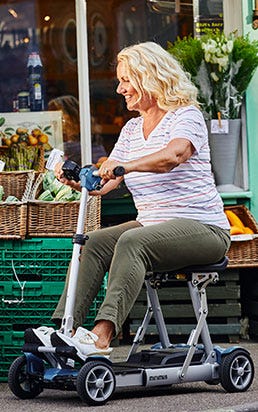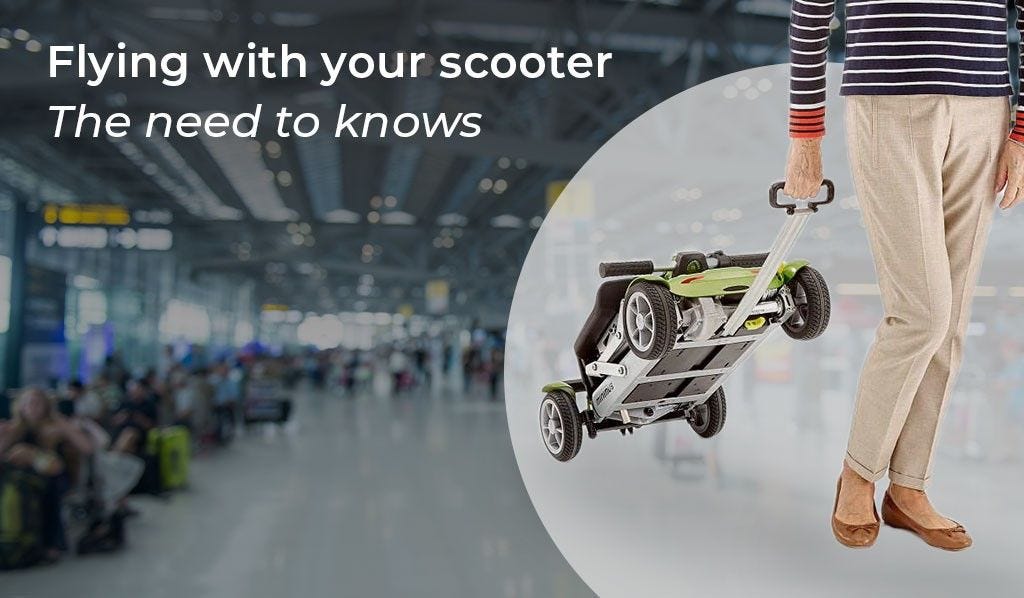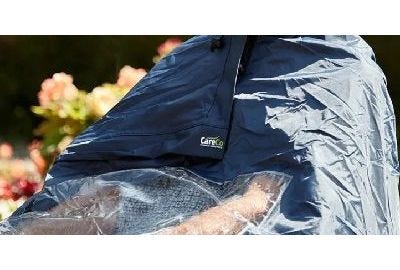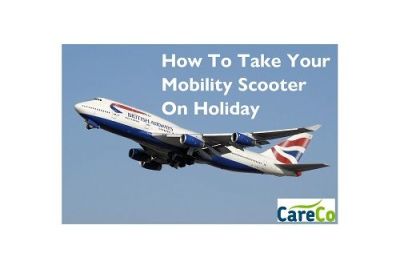If you are looking to purchase a new mobility scooter to on holiday abroad, then you need to understand which types of scooters are allowed on planes.
Click here to skip to our recommended airline friendly scooters
There are only really two restrictions to flying with a mobility scooter, the first being size, and the other being the power rating of lithium-ion batteries. As a general rule, any travel scooter with sealed lead-acid batteries is allowed on all flights, although airlines will always want to confirm this with you when you book.
Scooters do not need to fold down, and travel scooters, which can be dismantled, would normally be transported in one piece, maybe with the seat lowered and the tiller folded down. Small mobility scooters are generally treated in the same way as wheelchairs, and you should be able to travel with them, and receive aid to travel to the gate and then onto the plane when you have checked in your scooter.
Regardless of the type of mobility scooter you buy, you must always check with the airline before booking your tickets. For example, British Airways state on their website: “If your wheelchair, mobility scooter or mobility aid is battery-operated, you must let us know in advance …”.
BA always reminds customers that while their rules may accommodate your scooter (they will even put it in a container to help protect it), if a partner airline is used on a second leg of the journey, they may well have different rules, so it is important to check with them when booking too.
The Civil Aviation Authority (CAA) states: “Prior to travel, passengers must advise the airline of the type of batteries fitted to the mobility aid and how the device can be protected against inadvertent operation”, so it is important to know how to do this.
Airline Approved Lithium-ion Batteries
The biggest change in recent years is the introduction of lithium-ion batteries to power mobility scooters - we have a growing range here. These are very popular as they are lighter than traditional batteries, and allow small scooters to go many more miles without adding too much weight. They are also quicker to charge.
The CAA has set a rule that the maximum size of lithium-ion battery allowed for mobility scooters is 300Wh (Watt-hours). Some airlines dictate an even lower storage size, so always check with your airline before you book your tickets.
Some airlines may ask you to remove the battery from the scooter so it is carried into the cabin. This does mean that some electric folding scooters will cause a problem as once the battery is removed, they can’t be folded.
The CAA advice provides some explanation of when you might need to carry the battery with you:
Prior to travel, passengers must advise the airline of the type of batteries fitted to the mobility aid and how the device can be protected against inadvertent operation. The following methods are preferable:
- If a key is fitted, switch off the device and remove the key
- Remove the joystick module
- Separate power cable plugs or connectors
If the design of the electric mobility aid means that none of the above actions are possible, it is acceptable to:
- 'Lock out' the mobility by making a combination of movements with the joystick
- Disconnect cables from battery terminals and protect cables and terminals from short circuits.
- Application of the brake is not sufficient; unless the motor is rendered inoperative, the motor can still be activated and overheat.
- When the mobility aid does not provide adequate protection to the battery:
- the battery must be removed in accordance with the manufacturer's instructions and be carried in the cabin;
- the battery must not exceed 300Wh;
- the battery terminals must be protected from short circuit (by insulating the terminals, e.g. by taping over exposed terminals); and
- the battery must be protected from damage (e.g. by placing each battery in a protective pouch); and - the battery must be carried in the cabin.
Sealed Lead-Acid Batteries
Traditional mobility scooters are powered by two sealed lead-acid batteries. These are allowed on all flights, although some airlines may still impose a maximum limit based on weight.
All travel mobility scooters should be allowed, and it is possible some airlines will allow larger scooters too, such as pavement scooters like the CareCo Victory, which have 34Ah batteries, and it weighs 80kg. However, what is allowed is determined by the airline, and their rules may change at any time.
Most airlines will allow larger scooters, but you would need to agree this early, and it will be checked in to the hold through oversized luggage.
Ryanair, for example, state on their website: “Wheelchairs/Mobility Scooters weighing more than 150kg require pre-authorization and will not be accepted for carriage without this.” This implies that they would allow most scooter sizes.
KLM provides similar advice, and they provide electric wheelchair weight and size limits for different aeroplanes:
Your electric or battery-powered wheelchair can only be transported in the hold. It should meet the following size and weight requirements:
- Airbus A330s: maximum 152 x 139 x 149 cm, no maximum weight
- Boeing 737s: maximum 112 x 113 x 85 cm, no maximum weight
- Boeing 777s and 787s: maximum 152 x 139 x 149 cm, no maximum weight
- Embraer 175s, 190s, and 195-E2s: maximum 120 x 100 x 80 cm and maximum 149kg
Source: https://www.klm.co.uk/information/assistance-health/own-wheelchair
Although this talks about electric wheelchairs rather than mobility scooters, airlines, and other businesses, often classify mobility scooters as “electric wheelchairs”.
So, in theory, you can take road legal scooters, such as the Vega RS8 (94kg), on a plane. Of course, getting it to the airport, and then from the destination airport to your hotel, is another matter, which is why the smaller travel scooters that fit in a car boot are much more practical.
Should you Dismantle a Travel Scooter?
Our travel mobility scooters are designed to be easily dismantled into smaller parts so you can lift them into a car boot. However, it is not advisable to do this when flying, and instead hand your scooter over to airport staff in its complete state to reduce risk of parts being lost.
Protecting Your Mobility Scooter
Ideally, it should be protected - some airlines will offer a plastic wrapping service to help keep it together and reduce damage, while others will have dedicated containers for transporting mobility equipment. If you use our Minimus mobility scooter, you can also purchase a handy travel case to protect it.
CareCo’s Airline Friendly Mobility Scooters
Here’s a quick run-down of our airline friendly mobility scooters. Again, please check with your airline before booking, as rules vary and are subject to change.
Lightweight Lithium-ion Scooters
We have three lithium-ion scooters that should be accepted by most airlines:
- Li-Tech Air Lithium Scooter - 258Wh battery, 7 mile range, 38kg
- Minimus Folding Mobility Scooter - 278Wh battery, 9 mile range, 18kg
- AirFold Pro Carbon Scooter - 240Wh battery, 9 mile range, 20kg
We also have the Maximus Folding Mobility Scooter, which is a larger version of the Minimus. The standard model is not allowed on planes (it has a 662Wh battery) but we sell an optional AirSafe 248Wh battery.
Lightweight Lead-Acid Scooters
Although you should be able to take any of our lead-acid scooters on a plane, with permission, these are our recommended scooters:
- CareCo AirLite X - our cheapest scooter, with a 7 mile range
- Abilize Stride Sport - a Which? Recommended scooter, 17 mile range
- X-Go Pinnacle - our largest travel scooter, with a 22 mile range
- I-Go Vertex Sport - a great value 15 mile mobility scooter
Final Comments
Remember, always check with your airline when you start the booking process. They will ask about the make and model of your scooter, and will ask for the battery type and size, its dimensions, and weight, so have this information at hand; you should be able to find it all in the product manual, which you should take with you when you travel. They may also ask if you are able to disconnect the battery, so learn how to do this.
Also check what aid your airline provides you during transit. Some airlines offer specific aid packages, which you need to request in advance. The CAA provide some good advice on this topic: https://www.caa.co.uk/passengers/prm/arranging-special-assistance/


 Price Match Promise
Price Match Promise
 Next day delivery, 7 days a week
Next day delivery, 7 days a week
 Nationwide Showrooms
Nationwide Showrooms
 Rated Excellent
Rated Excellent





